
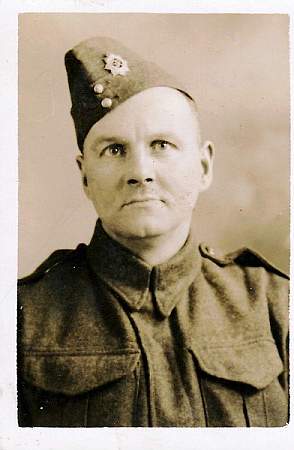
William George Stanley Bedford
(photo taken around 1939)
The following account of William’s time
in the army has been taken from a letter he had written to his Grandson Tim, who had
asked him to recall his time in the army.
William joined the army, the Royal Field Artillery, in 1919,
he gave his aged as 18 but in fact he was only 16. He served in the army for
six years and then a further 6 years on reserve. His Service Number was 275387.
In 1939 William was called up into the army again and was soon on his
way to France with the British Expeditionary Force to aid the French Army. They
sailed from Plymouth to Brest in north western France and then drove for 3 days
to the north of France bound for Verdnell (could not find this place on the
map).
For the next 7 months William spent his time working in
the cook house before getting orders to move to the front. Time was then spent
moving between France and Belgium before getting their next orders to abandon
their Lorries and equipment and make their way to Dunkirk,
In May 1940, during the Battle of
France, the British Expeditionary Force was cut off from the rest of the French
army by the German advance. Encircled by the Germans, they retreated to the
area around the port of Dunkirk. It was from here where
William along with 338, 225 troops were evacuated.
William was picked up by a little fishing boat and landed in
Ramsgate.
From Ramsgate he was taken to Manchester by train to a
first aid post and then the following day to hospital where he spent the next 3
weeks. (William later in life told his daughter that he had been shot in the
arm).
As they did not know where his unit was he was sent to Bulford camp
where he stayed for the next 3 months.
Eventually William found out that his unit was at
Hardingham in Norfolk and so he asked if he could go back to them. He was
joined there for a while by his wife.
The company was then moved up to Scotland for 6 months,
which was then followed by a move to Manchester for 3 months.
William’s section was then moved to Malvern Link
for 2 months, returning back to Manchester for a short time before finally
getting the orders that they were being posted to Singapore
The
following account of the voyagge to Singapore and the eventual capture and
imprisonment of the troops has been taken from various sources I found on the
internet.
They embarked at Avonmouth on the S.S. Oronsay and sailed on 28th October
1941. After a few hours in the Clyde they headed for Iceland and subsequently
Halifax, Nova Scotia. They arrived in Halifax on 8th November where they
received orders to transfer to an American vessel the US ship Dickman and be
ready to sail by midnight.
William recalls that
they sailed up the Irish Sea and picked up some more troops from Gourock
(Scotland). As they got half way across the Atlantic they were given an
American Navy escort into Halifax. (1 Air Craft Carrier, 2 Battle Ships, 2
Cruisers, and a Submarine)
By breakfast time on 10th November the convoy was heading south west for
Trinidad. After refuelling they sailed for Cape Town. On 9th December they
reached Cape Town, where they had a short break before sailing again on 13th
December.
William recalls that
they anchored off Trinidad for 2 days to take on supplies.
In Cape Town they were allowed ashore for the day,
and so they took a trip up to Table Mountain. Two Ladies asked William and his
pal Yorky if they wanted them to write home to their wife’s to let them know
that they were ok.
As they sailed through the
Indian Ocean William recalls them having Christmas dinner on deck. On the menu
was Turkey, roast potatoes and Pumpkin Pie, (but no Christmas pudding).
They sailed north to Bombay where
they stayed for four days before setting off, on New Year’s Day, for
Ahmednagar. After breakfast on 2nd January they set off on the long hot march
to East Ridge where they spent the next three weeks getting used to working under
tropical conditions.
On
January 23rd 1942 convoy BM12 departed Bombay for Singapore with 3,800 men from
the 9th & 11th Northumberland Fusiliers and their associated supplies. The
convoy consisted of the Empress of Asia, Felix Roussel, the Dutch vessel
Plancius, the Devonshire and later joined by the City of Canterbury (recently
involved in the mutiny at Durban). The Felix Roussel appears to have been
primarily carrying stores and supplies. The convoy was protected by a strong
naval presence, including HMS Exeter, the makeup of the escort changed as the
voyage progressed.
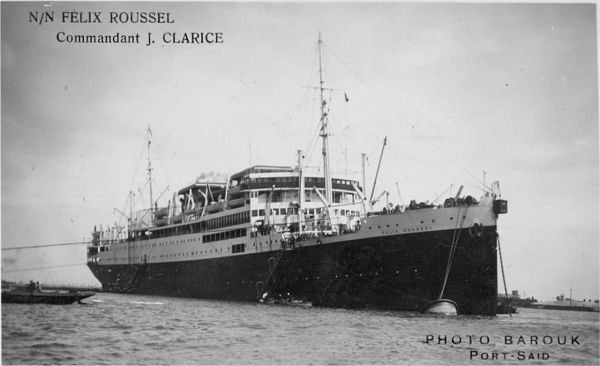
William was aboard the
ship Felix Roussel (pictured above).
After passing Ceylon the ship set a course for Australia and then suddenly
changed course to pass through the Sunda Srait dividing Sumatra and Java. Extra
precautions were now taken on board the Empress of Asia. Every available gun
was brought out and men detailed as gun crews under Capt. Watts. The ship was
literally bristling with guns and the men ready in case they were attacked by
low flying Jap aircraft. Standing Orders in the event of enemy attack were
posted throughout the ship and they had had a few practice alarms.
On the morning of February 4th 27
Japanese bombers flew over the convoy at high altitude and now within 24 hours
of their destination they heard the familiar whistle as a number of bombs were
dropped around the ship. That afternoon the convoy split, the faster portion
going on ahead whilst the Asia wallowed along as best she could with the Felix
Rouxelle and the Canterbury as company
The next morning, on the horizon, they sighted a pall of black smoke
hanging over what they later found out was Singapore. During the withdrawal of
the remaining arms and ammunition from the armoury the warning sounded and
within 2 ½ minutes everyone was at Action Stations. The Felix Rouxelle was the
first ship to receive a direct hit and was soon on fire. Luckily, a second direct hit landed in a water tank which burst and
the rush of escaping water put out the flames. Then it was the Empress of Asia’s
turn. The first wave of aircraft dropped their load wide and with a roar passed
over followed by a second wave almost on their tail. Columns of water spouted
all round but still the ship was untouched. Then a single plane appeared from
the blue. For a second they saw a bomb released and heard, above the din of
their own guns, the long swish getting louder and ending in a sickening thud.
The bomb had passed over the bridge, through the roof of the Officers’ lounge
and exploded somewhere below.
The enemy bombers then turned their attention on the escort ship
H.M.S.Exeter, but by skilful manoeuvring and intense A.A. fire, no hits were
registered and the attack was switched back to the Asia. More planes came over
and further bombs made hits on the ship. Unfortunately although the hoses were
run out there was no water to put out the fires as the pumps had been damaged
in the explosion caused by the first bomb. The ship was burning furiously and
it soon became evident that unless a miracle happened the Asia would soon be
burning from end to end. They hung on in appalling conditions until, at 1.0pm
the order was given to “Abandon ship”.
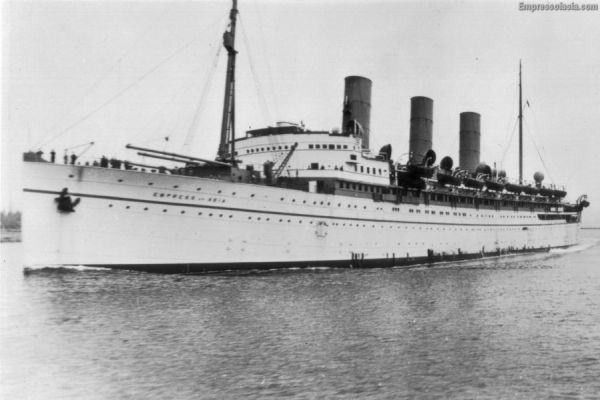
Empress of Asia (pictured above)
Despite the loss of the
Empress of Asia during the heavy bombing, the convoy went on to dock in Kepple
Harbour, Singapore and set down nearly 4,000 troops – many of who walked
straight into enemy hands. The four remaining ships CITY OF CANTERBURY,
PLANCIUS, DEVONSHIRE and the FÉLIX ROUSELL were the last troopships to dock in Singapore
before it fell to the Japanese on February 15th 1942.
Before the fall these ships, among many others, left Singapore carrying
thousands of evacuees. The FÉLIX ROUSSEL alone evacuated 1100 people to safety
in Bombay, including many British woman and children.
When William and his men landed
they got away from the docks as fast as possible. They moved in to a coconut
plantation but sadly lost a man when a coconut landed on his head which had
been dislodged by the blast of the guns. The men moved around but after only
ten days after landing they were taken prisoners of war on 15th
February.
At 8.00 am on 16th February the Japanese Army marched into Singapore and
the flag of the Rising Sun was hoisted over the Government buildings.
On 17th February the POW were marched to Changi some 20 miles away to
begin their 3 ½ years of captivity. (They were marched to the
northern tip of the island where they were imprisoned at a military base called
Selerang, which was near the village of Changi. The British civilian population
of Singapore was imprisoned in Changi jail itself, one mile away from Selerang.
Eventually, any reference to the area was simply made to Changi.)
The barracks at Changi had originally been built to accommodate about 4,000 men but by 20th February it was housing approximately 47,000 troops. Many of the buildings had been seriously damaged by bombing and shelling and to add to that the water supply, sewage system and electricity had been deliberately destroyed by the British engineers. Food was poor and in very short supply.
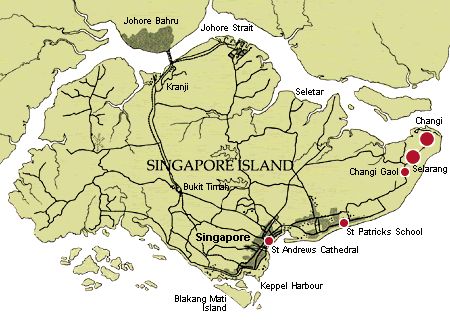
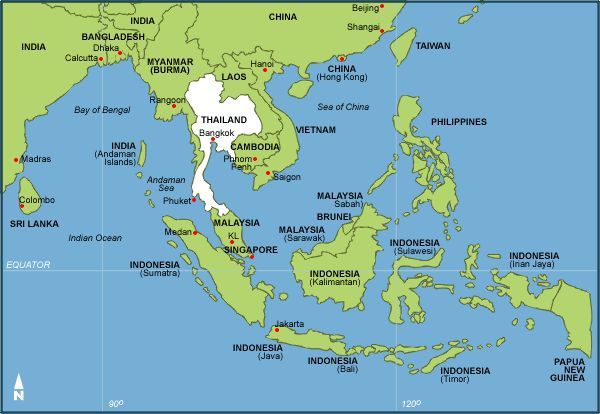
Click here to read about Changi POW camp
William recalled that
there was too many of them to be put in the prison so they were put into 3
compounds, the Australians in Selerang, the Sikhs in the middle and the British
in the old Indian huts.
When the Japs finally
got organised they started a working party of 40 men, all drivers, to collect
all the vehicles, William in the meantime had managed to set up a cook house
made from odds and ends and the drivers would bring back loaves, but when the
japs found out they put a stop to it. Later on two lads who had the jobs of
driving the Japs around fishing villages managed to bring back some vegetables.
William then went in
to hospital and when he came back to Changi, two working parties of men had
gone up country. The Japs had told them that it would be better for them as
they would get better food and the climate was much like England, but this all turned
out to be a lie. The parties were made up of British, Dutch, Malayans, Indians,
Javanese and Australians around 5,000 in total.
At the time the second party
went up country, William was in hospital with diphtheria and was put into isolation for 6 weeks. When
he came out he was sent to the officer’s quarters to cook for them.
After about a month
William, along with other POW got the orders that they were to move out, but no
one had any idea where they were going or to what kind of work they would be doing.
William and the men
were taken by lorry to Singapore station where they were joined by others. They
were put in to cattle trucks, 30 men to each truck, the trucks had 2 sliding
doors of which one had been taken off and positioned across the opening.
The men had to lay feet to feet
and the train journey took 5 days and nights stopping only once a day to pick
up cooked rice and tea. Going to the toilet meant having to be held by others
as you hung out the door way. (The
Journey was over 1200 miles)
They finally
arrived at Ban Pong station in Thailand and were there for 2 days while the
train was unloaded. On the third night the men were marched out on a 30 mile
trek to a camp at Kanchanaburi.
The men had no money to buy
water or food so they had to barter using they own items like watches, wallets,
blankets. At this camp you had to sleep anywhere you could to keep out of the
sun.
After 2 days rest the men set out on another 35
mile march, but this time William did not go with them as he was taken to the
hospital. The hospital was the school house, which had a roof but no sides and
an earth floor. The only other building was just a shack which was used for a
cook house.
In all, along with William, 56 men were left behind as the others continued the long march. (For some, it would be a march of 200 miles with men being dropped off at different places along the way).
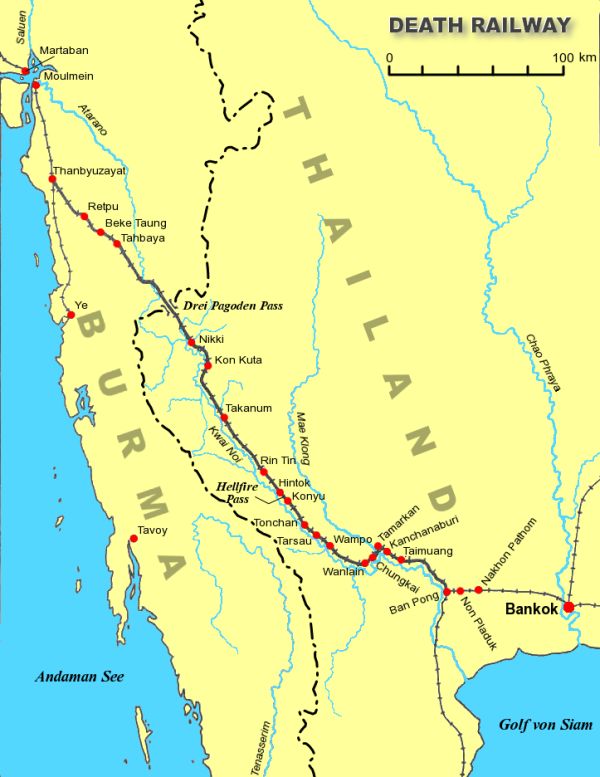
As time passed and the men got
better they sometimes re-joined other working parties as they stopped by on
their way up to the other camps. At the same time any solider that needed
hospital attention would be dropped off here. When William got better he asked
the M. O, (Medical officer) if he could re-join a working party, but he told William
that he wanted him to stay, and was only going to leave when he did.
Soon the last
working party had passed through the camp and as the remaining men got better
they had to go and work on the railway, cutting down trees to use for sleepers.
After working for 2
months the Japs started paying the men 3 cents a day and the officers $10 a
month, all which had to be repaid after the war.
As the men were going to stay
at this camp they had to build a hut using bamboo and coconut palm leaves.
In charge of the camp were 2
Korean’s who thought they were on to a good thing with the POW men now being
paid. They started stocking up on things like coconuts, eggs, bananas, cherry
tomatoes and tobacco brought from a china man that often use to pass by the
camp.
In the camp were 7 officers, 4
British and 3 Australians, a Major M.O., a Chaplin, 2 Captains, Interpreter,
and 2 Lieutenants. The Major through the Interpreter asked if he could have an Officers
Mess and as they had got some money they got the go ahead.
William was asked to
do the job, so he built a small hut, one side was for dining, it also had an
area for him to cook in and a little corner where he slept.
William then managed
to get in direct touch with the Chinese man who was selling the food. The Chinese
man, who was in hiding, would send out his scouts to let William know what time
he was coming, which was every day, except Thursday.
The Japs would take the men to
the sea, which was 2 miles away, it was the only time they could have a proper
wash until the rainy/monsoon seasons came.
When the first
working party came up from Singapore, they had brought with them a small piano
which they left at the camp William was at. The Japs tried to play it and one
night got all the POW in the camp to parade. The men all thought they were on
the move to somewhere but the Japs called for the Interpreter. They told the
men through him that they wanted all the men on parade to sing to the moon and
they would be rewarded with sweet tea, but no milk. An Australian asked if he
could give the men a tune and all the men sang along putting in a lot of bad
names. So every full moon the men would sing to it and if it was cloudy the
Japs would hang up a lantern and the men would have to sing to that instead.
To pass away the time at night
someone might give a lecture or the men would play board games like drafts or card
games.
There was 2 Jap
camps either side of the POW camp, one was the engineers and the other the
Cavalry, and they were a rowdy lot. One Thursday night they had been out
drinking and when they returned some of them started to fight with each other.
So a Captain ordered both sets of men to line up opposite each other and then gave
the order for the men to hit each other. One small men opposite a large men
only slightly hit him so the Captain said to him ‘hit him like this’ and the
Captain knocked the smaller man out.
The Japs had two horse that
died, so they buried them both in a large hole. Every day the Japs would put a
dish of rice and some bananas on the grave. The POW men would watch and wait
and when they got the chance at night time they would nick the food, but always
left the dish.
William writes that
the camp he was at was the best camp, some of them up country were really bad, men
were dying off like flies, so bad that they could not bury them, but instead
put the bodies in to piles and burnt them. A lot of the men only got back as
far as the next camp, which was the hospital camp, 5 miles away, but then died.
Eventually the railway line was completed and the order came to return back to Singapore and Changi prison. William remembers boarding the train, but nothing else until he got back to Selerang as he had come down with a fever, Malaria. The barracks were brick built and half of it was used as a hospital.
The men were there for about 3
weeks before being moved back to the Indian lines (huts) .
Each day William
along with others would go out to do gardening and grow vegetables.
The Japs wanted the POW to sign
a form to say that there would not try to escape, but the officers told the men
not to sign. So the Japs moved the women out of Changi prison, which was built
to hold 65 Europeans and 220 natives and moved in 18,000 men. Four men were in
a cell which was built to house one, it measured 7’ by 6’ and had a block of
concreate in the middle where one man laid, two men slept either side and one
in the doorway. 50 men laid on the cat walk, head to head and also on the wire ventilate,
this was on all 3 floors.
There were men on the roof, out in the exercise
yard, in the workshops, they had to build 4 big huts outside the officers, the
warden quarters.
Men were still being sent out
to work, William had a job working by the sea digging dugouts for a Jap
general. It was not a bad job as they worked for an hour and then had 10
minutes cooling off in the sea and so on. The used to get tit bits of the
Generals cook without him knowing.
When that job
finished William was moved out of the jail to the other side of Singapore to a
woodland, here William set up a cookhouse and ran that for 5 months.
William then asked if
he could work outside and he was given a job with another 16 men tunnelling in
the hills to make shelters for the Jap stores. One day they went out but were
not made to work, this was followed by more days like this and eventually the
going out stopped all together. The officers began to worry that something was
wrong.
Without warning,
Gurkha soldiers came in to the camp and handed out fags, then about four hours
later Lord Mountbatten arrived, he got up on a trailer and told the men it was
all over.
Then Lady
Mountbatten arrived with the Red Cross and informed them that the Red Cross would
be going to take the sick first and then more transport would follow to take
the rest of the men.
William was among the
third party to leave the camp and they were put aboard a Dutch ship.
On his way out William
remembers that they passed the ship that had brought them to Singapore, the
ship sailed through the Indian Ocean to Colombo in Ceylon (Sri Lanka).
The ship docked here for 2 days
and William brought 2 scorpion brooches there, one was for his wife and the
other for his daughter.
The ship then set sail again through the Arabian Sea to Aden where it stopped for 2 days. William recalls that they got some clothing here and went to see a show.
They set sail once more, through the Red sea to the Suez Canal and Egypt and on through the Mediterranean Sea, into the Atlantic Ocean and up into the Irish sea to Liverpool and home.
Taken From Japanese Index Cards of
Allied Prisoners of War and Internees (1942)
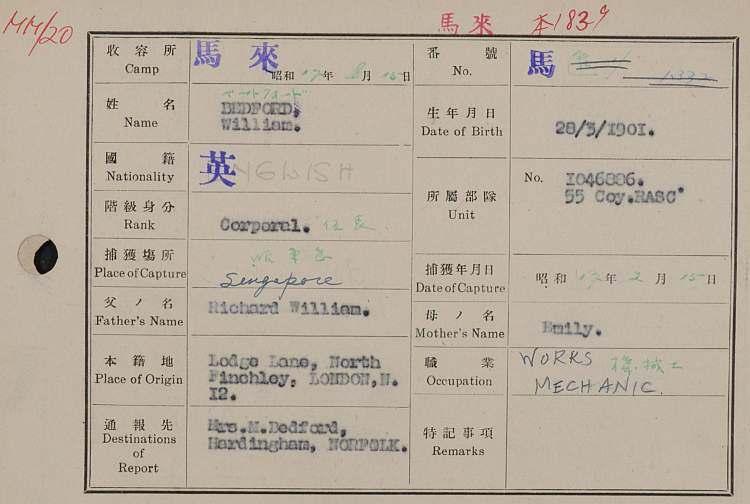
A Prisoners of War Camp Registration Card (1943)
Occupation: Works Mechanic
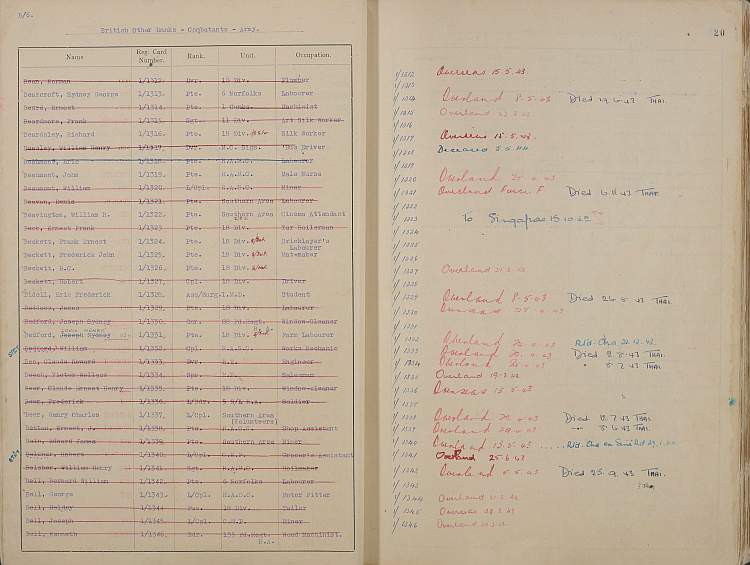
Prisoners of war, Far East: F Force Working Party, Thailand; nominal roll.
Column on the right shows who had died (D) followed by the date and those alive with camp name CHA (changi)
on this page alone, out of 47 names 34 had died.
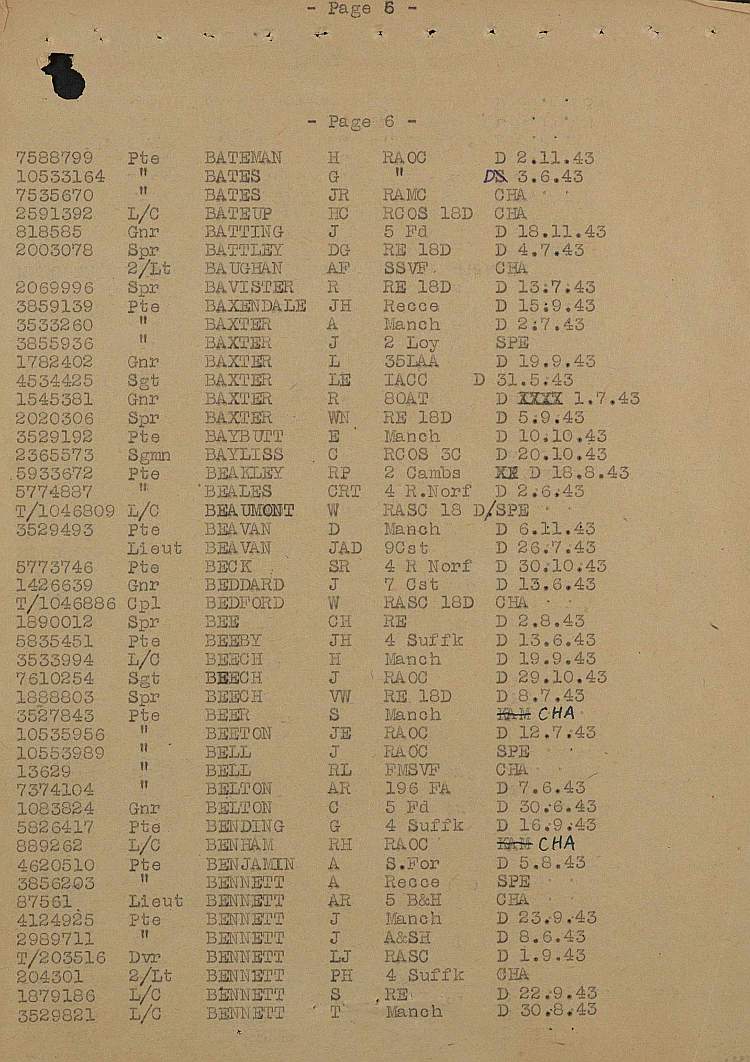
"F" Force - British Summary as at 30 April 44
This page shows both the number of British and A.I.F. (Australian Imperial Force) Pow who departed as a working party to Thailand and Burma and how many (returned) ALIVE as at 30 April 1944
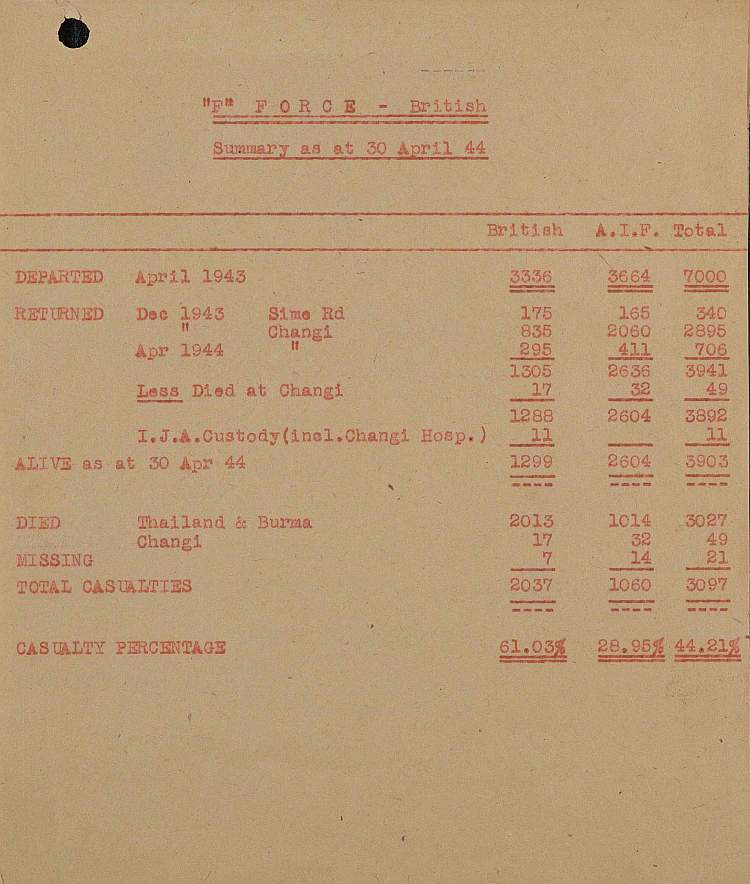
"F" Force - British Summary as at 31Mar 44
This page shows in more detail the number of British Pow who departed as a working party to Thailand and Burma and how many (returned) ALIVE
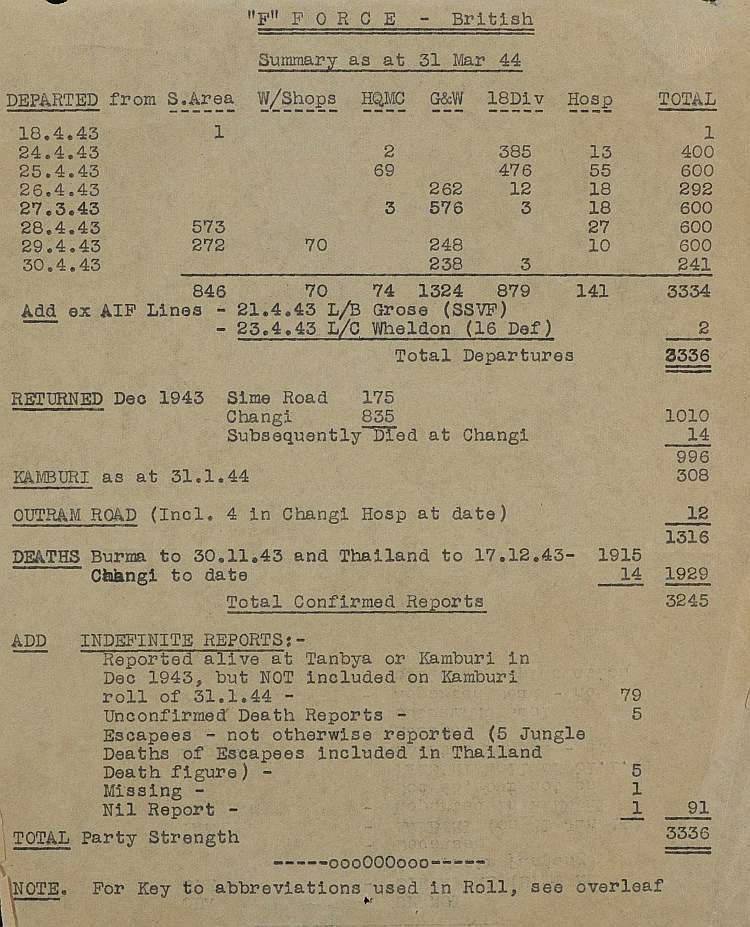
Click here to read about the The ill Fated "F" Force
and the conditions suffered by them
Malaya PoW Camp Name List (1944)
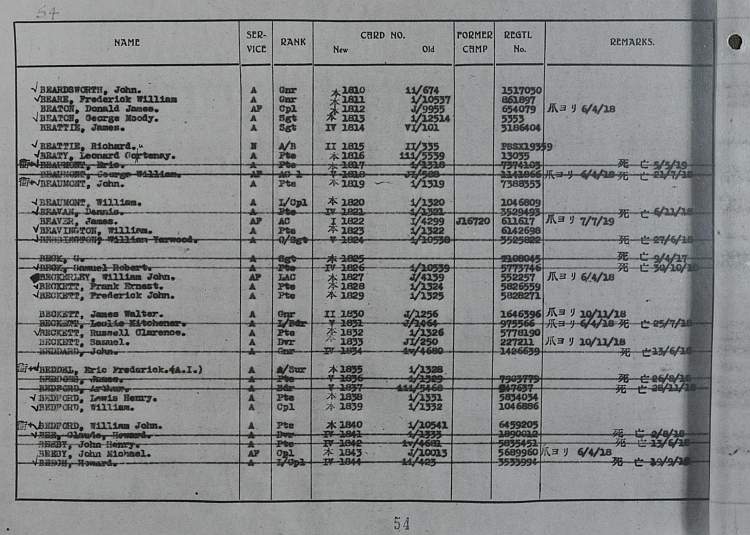
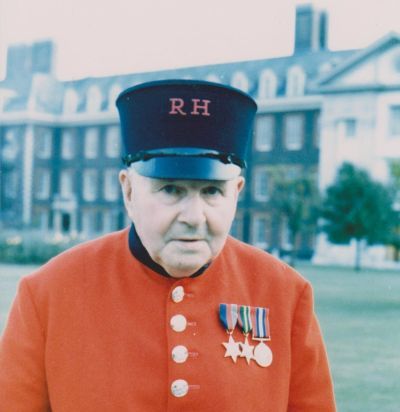
(photo taken around 1985)